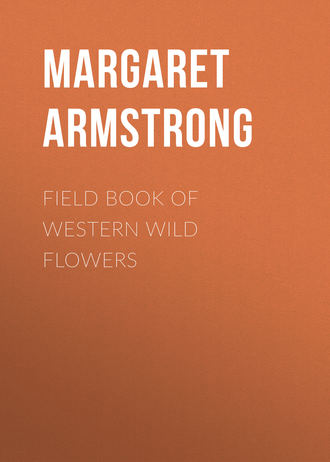 полная версия
полная версияField Book of Western Wild Flowers
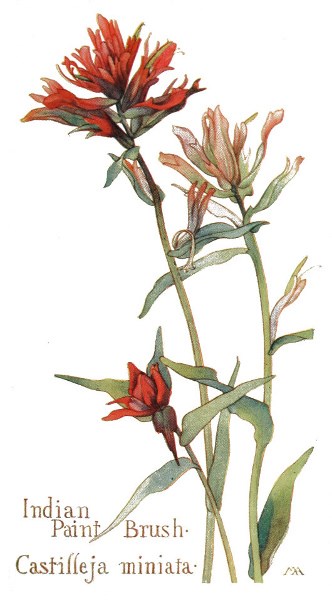
Indian Paint Brush – Castilleja miniata.
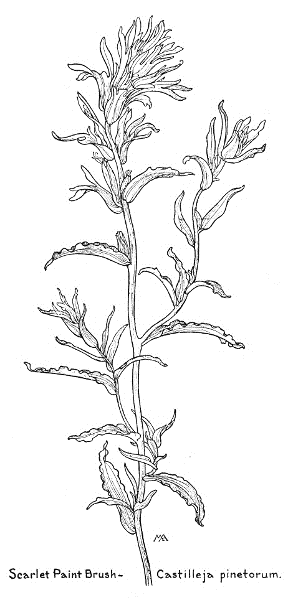
Scarlet Paint Brush – Castilleja pinetorum.
There are a good many kinds of Stemodia, widely distributed, only two in the United States; the corolla blue or purplish and two-lipped; the stamens four, not protruding.
Stemodia
Stemòdia durantifòlia
BlueSpring
Southwest, etc.
This is a rather pretty plant, which is quite effective when growing in quantities. The stem is hairy and sticky, from a foot to a foot and a half tall, with hairy leaves, which have a few sharp teeth. The flowers are three-eighths of an inch long, with sticky-hairy calyxes and bright purplish-blue corollas, white and hairy in the throat. This has a slightly unpleasant, aromatic smell and grows in moist spots, often in mountain canyons near streams, as far east as Texas and also in the tropics.
There are many kinds of Linaria, most abundant in the Old World; herbs; the upper leaves alternate, the lower opposite, usually toothless; the corolla like Antirrhinum, but with a spur; the stamens four, not protruding.
Toad Flax
Linària Canadénsis
Blue, lilacSpring, summer
West, etc.
A slender plant, from six to eighteen inches tall and smooth all over, with branching stems, dark green leaves, and pretty little flowers, delicately scented, from a quarter to half an inch long, with bright purplish-blue or pale lilac corollas, veined with purple. This is found in dry soil across the continent and sometimes grows in such quantities around San Diego as to form blue patches in the landscape.
There are many kinds of Veronica; ours are rather low herbs, though some are trees in the tropics, widely distributed, living in meadows and moist places; flowers small, usually blue or white, never yellow; calyx with four divisions, rarely five; corolla wheel-shaped, with a very short tube and four, rarely five, lobes, the lower one narrower than the others; stamens two, sticking out at each side of the base of the upper lobe; anthers blunt, with slender filaments; ovary two-celled, with a slender style and round-top stigma; capsule more or less flattened, two-lobed or heart-shaped, splitting open, containing few or many seeds. They were named in honor of St. Veronica.

Toad Flax – Linaria Canadensis.
Stemodia – S. durantifolia.
Hairy Speedwell
Verónica Tournefórtii
Blue
Spring, summer, autumn
Utah, Cal., etc.
This is one of the most attractive of the little Speedwells, for its flowers are bright and quite large. The stems are branching, hairy and purplish, some short and erect, others long and trailing, and the leaves are alternate above and opposite below, dull yellowish-green, hairy and rather soft, with scalloped edges. The flowers grow singly, on slender flower-stalks over an inch long, springing from the angles of the upper leaves, and the corolla is three-eighths of an inch across, the upper lobe deep brilliant blue, veined with dark blue, the side lobes similar in color but not so bright, the lower lobe almost white, without blue veins, and each lobe with a little pale yellow at its base. The stamens and pistil are white, the anthers becoming brown and the style bent to one side, and the capsule is somewhat heart-shaped, containing several cup-shaped seeds. This forms patches along roadsides and in fields, the soft foliage dotted with the quaint bright blue flowers, opening a few at a time in bright sunlight and closing at night. This is a native of Europe and Asia and is found across the continent.
American Brooklime
Verónica Americàna
BlueSummer
Across the continent
In shallow water, or in very wet meadows, we find these little flowers. They are smooth perennials, with straggling, branching, purplish stems, more or less creeping, and rooting from the lower joints, from one to three feet long. The yellowish-green leaves usually have short leaf-stalks and are often toothed and the very small, pale blue flowers, with white centers and veined with purple, grow in loose spreading clusters.
Alpine Speedwell
Verónica Wormskjòldii
Blue
Summer
Northwest, Ariz., etc.
A pretty little plant, with smooth, stiffish, toothless leaves and deep bright blue flowers, with a little white at the base of the petals and veined with purple. This is found in damp spots in the mountains, up to twelve thousand feet, in northern places across the continent, and as far south as Arizona.
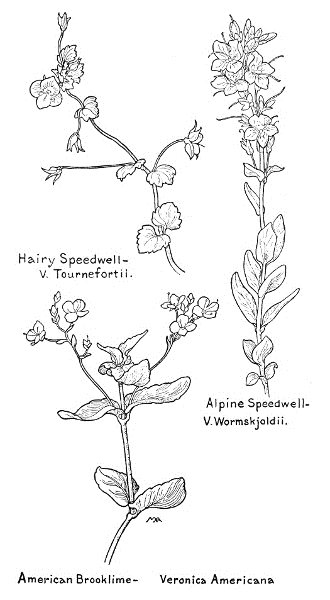
Hairy Speedwell – V. Tournefortii.
Alpine Speedwell – V. Wormskjoldii.
American Brooklime – Veronica Americana.
There are a great many kinds of Pentstemon and some of our handsomest and most conspicuous western flowers are included among them. They are natives of North America, chiefly herbs, sometimes branching below; the leaves usually opposite, the upper ones without leaf-stalks and more or less clasping; the flowers showy, in long clusters; the calyx with five lobes; the corolla two-lipped, with a more or less swollen tube, the upper lip two-lobed, the lower three-cleft and spreading; the stamens four, in pairs, and also a fifth stamen, which is merely a filament without any anther, but is conspicuous and often hairy; the style threadlike, with a round-top stigma; the pod usually pointed; the seeds numerous. The common name, Beard-tongue, is in allusion to the usually hairy tip of the sterile filament. Pentstemon is from the Greek meaning five stamens. This name is often mispronounced; the accent should be on the second syllable and long.
Large Beard-tongue
Pentstèmon glandulòsus
Lilac, purple
Summer
Oreg., Wash., Idaho
An exceedingly handsome plant, a foot and a half tall, with a stout reddish stem, rather downy and sticky, and dark green leaves, rather shiny and stiff, and downy on the under side. The flowers are an inch and a half long, so large that they look like Fox-glove, and are beautifully shaded from pale lilac to deep reddish-purple, with purple filaments and white anthers and pistil. The calyx is reddish, sticky and downy, and the outside of the corolla glistens with sticky fuzz. This grows in the mountains.
Pentstemon
Pentstèmon Rattáni var. mìnor
BlueSummer
Utah, Oreg., Cal.
This forms pretty clumps of bright color, with several stems about eight inches tall, smooth below, and smooth dark green leaves. The flowers are less than half an inch long, with a downy calyx and bright purplish-blue corolla, with a purplish throat. This grows in mountain canyons.
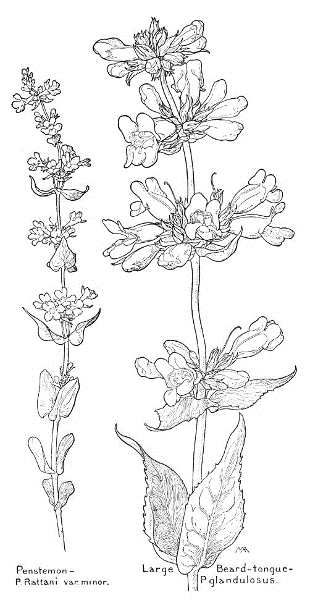
Penstemon – P. Rattani var. minor.
Large Beard-tongue – P. glandulosus.
Blue Pentstemon, Beard-tongue
Pentstèmon cyanánthus
Blue
Spring, summer
Utah, Ariz., Wyo.
This is perhaps the most beautiful of all the Pentstemons, with several smooth, stoutish, pale green, leafy stems, from one to two feet tall and smooth, pale bluish-green leaves, with more or less "bloom," toothless and thickish, the upper ones somewhat clasping. The flowers are not hairy or sticky, and are over an inch long, forming a handsome cluster about eight inches long. The sepals are narrow and pointed, the corolla is tinted with various beautiful shades of blue and purple, often with a white throat and blue lobes, or with a pink throat and deep blue lobes, the sterile filament has a thickened, more or less hairy, yellow tip, and the pale yellow anthers are more or less hairy. This plant is beautiful in every way, for the foliage is fine in form and color and the flowers are brilliantly variegated, yet harmonious and graceful. This grows on hillsides and in mountain valleys, at rather high altitudes, and used to be common and conspicuous on the "benches" around the Salt Lake Valley, but it is gradually being exterminated by sheep. It thrives and improves when transplanted into gardens. P. acuminàtus is similar, but the cluster is looser and the flowers often pink and purple. It forms fine patches of color at the Grand Canyon.
Honeysuckle Pentstemon
Pentstèmon cordifòlius
Red
Summer
California
A handsome shrub, with much the general appearance of a Honeysuckle, woody below, with long slender branches and pretty heart-shaped leaves. The flowers are often in pairs and are each an inch and a half long, with bright scarlet corollas, conspicuously two-lipped, the stamens protruding, and form large clusters towards the ends of the branches. This grows in light shade in the woods and trails its long branches and garlands of bright flowers over the neighboring shrubs and trees.
Pride-of-the-mountain
Pentstèmon Newbérryi
Pink, lilac
Summer
California
A beautiful little shrub, making splendid patches of vivid color on high bare rocks in the mountains, where it is very conspicuous, hanging over the edges of inaccessible ledges. The stems are woody below and very branching, about a foot high, and the leaves are usually toothed, smooth, stiffish, and thickish. The flowers are an inch and a quarter long, with a rather sticky calyx and bright carmine-pink corolla, moderately two-lipped, with a patch of white hairs on the lower lip; the stamens protruding, with conspicuous, white, woolly anthers, and the style remaining on the tip of the capsule like a long purple thread. This is slightly sweet-scented and is common around Yosemite. The alpine form is less than four inches high, with larger, lilac flowers and toothless leaves.
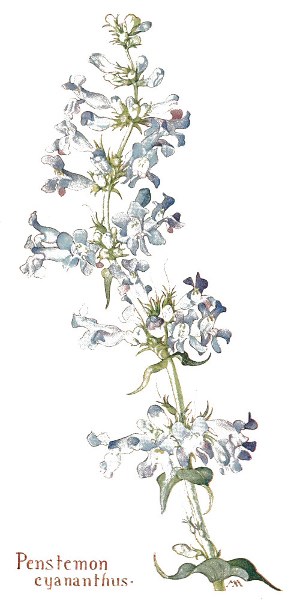
Penstemon cyananthus.
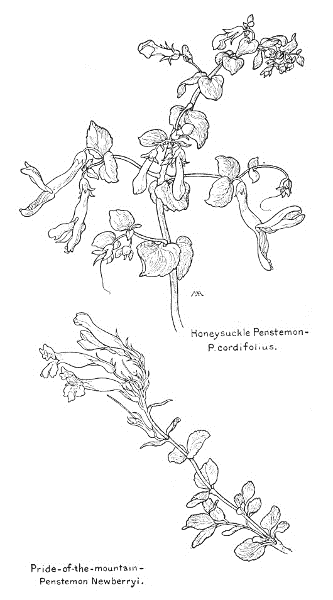
Honeysuckle Penstemon – P. cordifolius.
Pride-of-the-mountain – Penstemon Newberryi.
Bushy Beard-tongue
Pentstèmon antirrhinoìdes
Yellow
Spring
California
This is a rather pretty shrub, about four feet high, with pale woody branches, purplish twigs, and many, small, rich green leaves. The flowers have a glossy, bright green calyx and a yellow corolla, which is three-quarters of an inch long, streaked with dull-red outside and slightly hairy, the sterile stamen hairy and yellow.
Variable Pentstemon
Pentstèmon confértus
Yellow, blue, purple
Summer
Northwest and Cal.
This has a smooth stem and smooth, toothless leaves, but is very variable both in form and color, for the typical plant, from Oregon and the Rocky Mountains, has yellow flowers, but in Yosemite the variety caerùleo-purpùreus always has blue or purple flowers, but the plants vary in general appearance. In good soil, such as the floor of the Valley, the stem is sometimes two feet tall and the flowers are about half an inch long, grouped in whorls along the stem, but at high altitudes the plant shrinks to a few inches in height.
Cardinal Pentstemon
Pentstèmon Párryi
Scarlet
Spring
Arizona
These wands of flaming scarlet are conspicuous along the trails in the Grand Canyon and are exceedingly beautiful, very graceful in form and vivid in color. The smooth, purplish, somewhat leafy stems, from one and a half to two feet tall, spring from a clump of rather small leaves, which are toothless, smooth, and rather light green in color. The flowers are three-quarters of an inch long, the corolla with five rounded lobes and very slightly two-lipped, and look something like Scarlet Bugler, but are smaller and more delicate, and are sometimes mistaken for Cardinal Flowers by people from the East.

Penstemon Parryi.
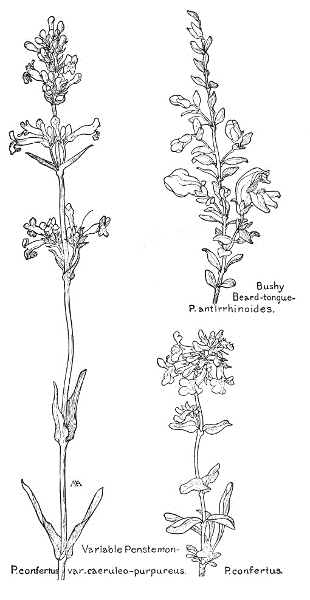
Bushy Beard-tongue – P. antirrhinoides.
Variable Penstemon – P. confertus. var. caeruleo-purpureus.
P. confertus.
Pentstemon
Pentstèmon Wrìghtii
Pink, purple
Spring
Arizona
This is very much like the last in every way, except the color of its flowers. The leaves are smooth and thickish, bluish-green, with a "bloom," the lower ones with a few irregular, blunt teeth, or with wavy margins, and the flowers, which are the same shape and size as the last, are deep, bright pink, with a magenta line on each lobe and some white hairs on the lower lip. The filaments are purple, with whitish anthers, and the fifth stamen resembles a tiny brush, with yellow bristles on the upper side and pointing into the throat. The whole effect of the graceful flower-cluster is bright, beautiful, and conspicuous, growing among the rocks, on hillsides and in canyons.
Pentstemon
Pentstèmon laètus
Blue, purple
Summer
California
This is very beautiful and varied in color and is the commonest kind in Yosemite, from one to two feet high, with roughish, toothless leaves and several slender, erect, somewhat hairy branches, ending in long loose clusters of flowers. The corollas are an inch long, and vary from deep bright blue through all shades of violet to deep pink, with two white ridges in the throat, and with two white anthers visible and two purple ones hidden in the throat. The flowers' faces have a quaint, wide-awake expression. This grows on dry rocky slopes and is often mistaken for P. heterophýllus, which is rather common in open places in the Coast Ranges. P. linarioìdes, blooming in late summer at the Grand Canyon, is somewhat similar, but the flowers are smaller and more delicate, and the leaves are smooth, small, and narrow.
Scarlet Bugler
Pentstèmon Èatoni
Red
Spring
Ariz., Utah
Very beautiful, from two to three feet high; with purplish stems, smooth leaves, and flowers an inch long, with a bright scarlet, funnel-shaped corolla, not much two-lipped, the stamens not protruding. These graceful wands of vivid color are conspicuous in the Grand Canyon. P. centranthifòlius, common in California, is similar, the corolla less two-lipped, and has very smooth, thickish leaves. P. Bridgésii, found in Yosemite, is similar, but the corolla is decidedly two-lipped.
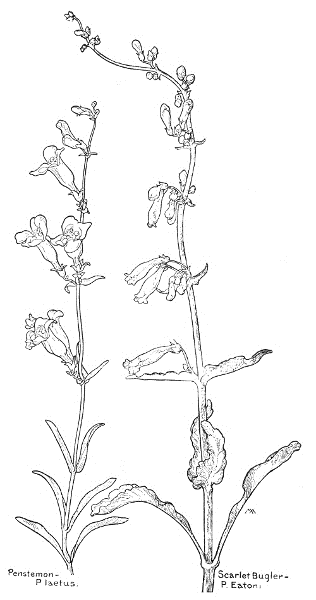
Penstemon – P. laetus.
Scarlet Bugler – P. Eatoni.
Yawning Pentstemon
Pentstèmon breviflòrus
Flesh-color
Summer
California
A bushy plant, from two to five feet high, with many smooth, slender branches, terminating in long loose clusters of flowers. The leaves are smooth, rather dark green, the lower ones sharply toothed, and the flowers are three-quarters of an inch long; the corolla flesh-color, tipped with pink, with some purple lines on the lower lip, and some fine white hairs on the upper; the buds yellow, tipped with dark red. These flowers are too dull in color to be effective, but they are sweet-smelling and have ridiculous faces with widely yawning mouths. This is quite common in Yosemite, forming large clumps on open rocky slopes. Indians use the tough stems for making baskets.
Scarlet Pentstemon
Pentstèmon Tórreyi
Red
Summer
Arizona
Exceedingly handsome, with smooth, pale green stems, two feet or more tall, and smooth, rather bluish-green leaves, with slightly rippled edges. The corolla is an inch and a quarter long, vivid scarlet, paler inside, strongly two-lipped, with long, conspicuous stamens, with pale yellow anthers, the style remaining on the tip of the capsule like a long purple thread. This makes splendid clumps of gorgeous color and is common on the rim of the Grand Canyon.
There are a number of kinds of Collinsia, natives of North America, with the leaves opposite or in whorls; the flowers single or in whorls; the calyx five-cleft; the corolla irregular, with a short tube and two-lipped; the upper lip two-cleft and more or less erect, the lower lip larger and three-lobed, the side lobes spreading or drooping, the middle lobe keel-like and folded together and enclosing the two pairs of stamens and the threadlike style, which has a small round-top or two-lobed stigma. The fifth stamen is represented by a minute gland on the upper side of the corolla tube near the base. The form of the flowers somewhat suggests those of the Pea Family. If we pull the lower lip apart we find the odd little crevice in which the stamens are concealed.
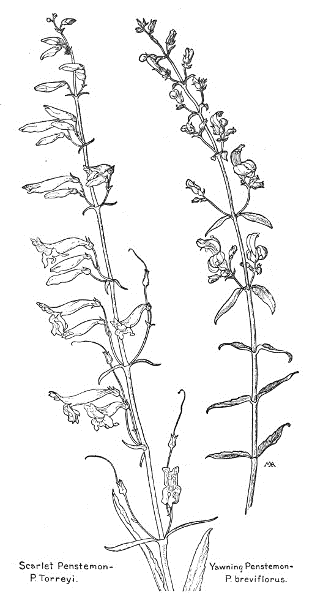
Scarlet Penstemon – P. Torreyi.
Yawning Penstemon – P. breviflorus.
Chinese Houses
Collínsia bícolor
Purple and white
Spring, summer
California
These are charming plants, from six inches to a foot and a half tall, with very delicately made flowers. The leaves are smooth or downy and more or less toothed, with rough edges, and the flowers are arranged in a series of one-sided clusters along the upper part of the stem, which is more or less branching. The corollas are about three-quarters of an inch long and vary in color, being sometimes all white. In the shady woods around Santa Barbara they often have a white upper lip, which is tipped with lilac and specked with crimson, and a lilac lower lip, and here they are much more delicate in appearance than on the sea-cliffs at La Jolla, where they grow in quantities among the bushes and are exceedingly showy. In the latter neighborhood the flowers are nearly an inch long and the upper lip is almost all white and marked with a crescent of crimson specks above a magenta base, and the lower lip is almost all magenta, with a white stripe at the center, the contrast between the magenta and white being very striking and almost too crude. The arrangement of the flowers is somewhat suggestive of the many stories of a Chinese pagoda and the plant is common.
Blue-lips
Collínsia multiflòra
Lilac, blue, and pink
Summer
Northwest
A very attractive little plant, smooth all over, about six inches tall, with toothless, light green leaves and pretty flowers, each over half an inch long. The upper petals are pinkish-lilac, the lower petals a peculiar shade of bright blue, and the tube is pink; the contrast between the blue and pink giving an odd and pretty effect. This grows in the woods around Mt. Shasta.
There are many kinds of Scrophularia, most of them natives of Europe. They are rank perennial herbs, usually with opposite leaves; the corolla with no spur and with five lobes, all erect except the lowest one, which is small and turned back; the stamens five, four of them with anthers and the fifth reduced to a scale under the upper lip. These plants are supposed to be a remedy for scrofula.
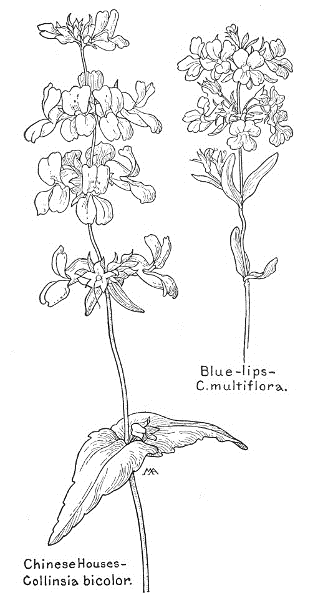
Blue-lips – C. multiflora.
Chinese Houses – Collinsia bicolor.
California Bee-plant
Scrophulària Califórnica
Red, green
Spring, summer
Northwest, Cal.
This is a coarse plant, smooth, or rather sticky and hairy, with several stout, square stems, and forming a large clump, from two to six feet high. The little flowers have a quaint appearance, but are usually only about a quarter of an inch long, with brownish-red or greenish corollas, which are neither pretty nor conspicuous, but the variety floribúnda, of southern California, has flowers which are nearly half an inch long, with rich red corollas, handsome and brilliant in effect. These plants yield a great deal of honey and are common and widely distributed.
There are several kinds of Diplacus, much resembling Mimulus, except that they are shrubs, with evergreen leaves.
Sticky Monkey-flower, Bush Monkey-flower
Diplácus longiflòrus (Mimulus)
Salmon-color (varying from pale yellow to red)
Spring, summer
California
When in full bloom, this is a handsome and very conspicuous shrub, for the flowers are numerous and unusual in coloring, being usually a peculiar shade of salmon-color, which at a distance gives the effect in the landscape of some sort of exotic rhododendron. It is from two to six feet high, with very dark green, sticky, usually toothless leaves, with their margins rolled back, dark sticky buds and large flowers, which are sometimes three inches long, the corolla varying in color from almost white to scarlet, with a white stigma. They bloom more or less all the year round and there are several similar, named varieties.
Bush Monkey-flower
Diplácus puníceus (Mimulus)
RedSpring, summer, autumn
California
This is much like the last, and is often very handsome. In the crevices of the sea-cliffs at La Jolla it makes tangled thickets of woody stems and dark green foliage, ornamented with many scarlet or rich deep-red flowers, with a velvety surface like that of a pansy and with orange ribs in the throat. This is common throughout California.

Bush Monkey-flower – Diplacus longiflorus.
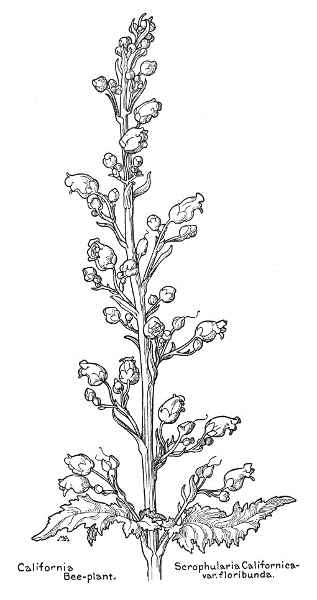
California Bee-plant – Scrophularia Californica var. floribunda.
There are many kinds of Mimulus, or Monkey-flower, usually growing in moist places, with erect or slanting, juicy stems; leaves opposite, usually toothed; flowers generally handsome, on flower-stalks from the axils of the leaves; calyx covering the tube of the corolla, bell-shaped, five-angled and five-toothed, upper tooth usually larger; corolla two-lipped, the upper lip with two lobes, erect or turned back, the lower with three, rounded, spreading lobes, the tube not swollen at base and with a pair of ridges within on the lower side; stamens four, in pairs, not inclosed in the upper lip, their two anther-cells spreading apart, no rudiment of a fifth stamen; style threadlike, stigma with two, flat, spreading tips. When an insect alights it touches the stigma, which immediately folds its tips together, thus exposing the anthers, so that the insect becomes dusted with pollen. This can be observed by touching the stigma with a pencil. The odd little grinning face of these flowers suggested both the common name and the Greek, derived from "ape."

